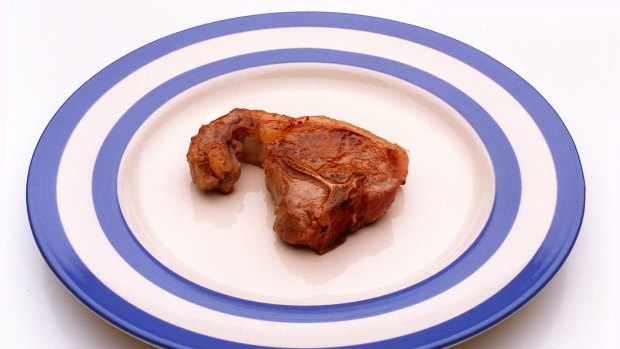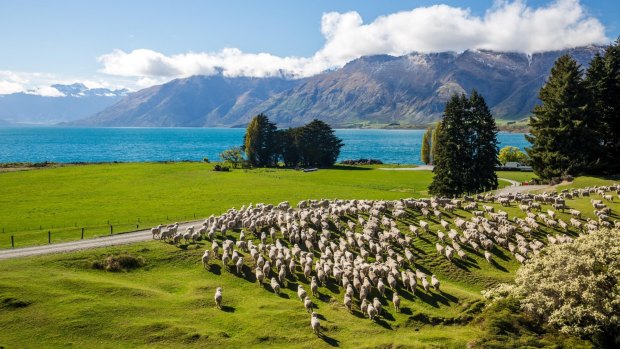This was published 9 years ago
Kiwis turn to Australian produce as New Zealand dollar rises
By Luke Malpass
Many Kiwis sat down to something unusual over Christmas – a table laid with an Australian lamb as the centrepiece. And with Kiwi lamb fetching almost double the supermarket retail price of an Australian chump, and the trans-Tasman currencies heading toward parity, it could be a more regular site on Kiwi tables.
The New Zealand dollar is currently buying A95.65¢, pushing towards its post float high of 1983 and even toward parity, a level not achieved since October 1973.

Lamb's meatCredit: Robert Banks
The last time the New Zealand dollar reached parity with the Aussie was on October 18, 1973, during the days of the Whitlam government, and two days after OPEC lifted the price of oil by 70 per cent, causing the 1970s oil shocks. It lasted for one day.
And although the dollar is only part of the Christmas lamb story (a shortage of Kiwi stock and drought-induced glut of Australian product being other reasons), if the Kiwi/Aussie cross remains at current levels or even creeps closer to parity, Australian primary exporters could be the big winners.

Of NAB's loans in New Zealand, 19 per cent, or NZ$13.6 billion, are to agribusinesses.
Sheepmeat, beef, wine and tourism and even local retail could benefit.
"It's good news clearly for a number of sectors here in Australia – fewer tourists going to New Zealand means more support for domestic tourism, and may also provide some support for retailers if people are staying here rather than going overseas," Commsec chief economist Craig James said.
"It will also provide competitive support for wine, dairying, sheep, meats basically and also the wool industry," Mr James said.
According to Woolworths-owned Countdown New Zealand spokeswoman Kate Porter, Countdown bought a limited amount of pre-Christmas Australian lamb, which was sold at $NZ10.99 a kilogram, compared to $NZ18.49 for local product.
"We bought specific stock in to sell over the Christmas period," Ms Porter said.
"Currency is obviously a factor but there is a much broader picture when everybody wants lamb."
Ms Porter said that while Countdown always attempts to source New Zealand lamb, when demand is high and the prices become expensive, Australian sheep and beef become viable alternatives.
"It seems to be actually every decade or so the Kiwi tends to test the highs against the Aussie, it's had a number of attempts to get to parity and it's failed on the last two attempts in the mid-90s and the mid noughties, but this time around certainly has got a lot more in its favour," Mr James said.
"The Australian economy is tending to underperform ... while the New Zealand economy has got a degree of momentum."
According to the Department of Foreign Affairs and Trade, New Zealand is Australia's sixth most important trading partner, representing two-way trade of $21.5 billion in 2013, some $11 billion of which are exports.
For New Zealand, however, Australia is its single most important market, accounting for 19 per cent of two-way trade.
"Australia is much more of a mining, resource producer, ore exporter rather than agriculture, which New Zealand tends to be focused on, so New Zealand has been supported by a strong demand for dairy and agriculture products generally, particularly out of China," Mr James said.
The post-earthquake rebuilding of Christchurch as well as four consecutive Reserve Bank of New Zealand rate rises, bringing the OCR to 3.5 per cent, have also supported the Kiwi unit over the past year.
"In contrast to that here in Australia, the iron ore price here in Australia, the prices have been weakening, and the other factor is the oil prices are coming down, something that is negative for an energy producer such as Australia, so the Aussie dollar has been softening in relation to that."
The price of Brent crude has dropped to $US57.88 a barrel, down almost 50 per cent, while the Quingdao iron ore price, landed in China, is $A68.71 a tonne, down from over $135 in January 2014.
"Those two factors have basically seen the Kiwi dollar climb its way higher against the Aussie dollar," Mr James said.
As the Kiwi unit edges higher and flirts with parity, it is closer to breaking its highest level against the post-float Australian dollar of $NZ1.0421.